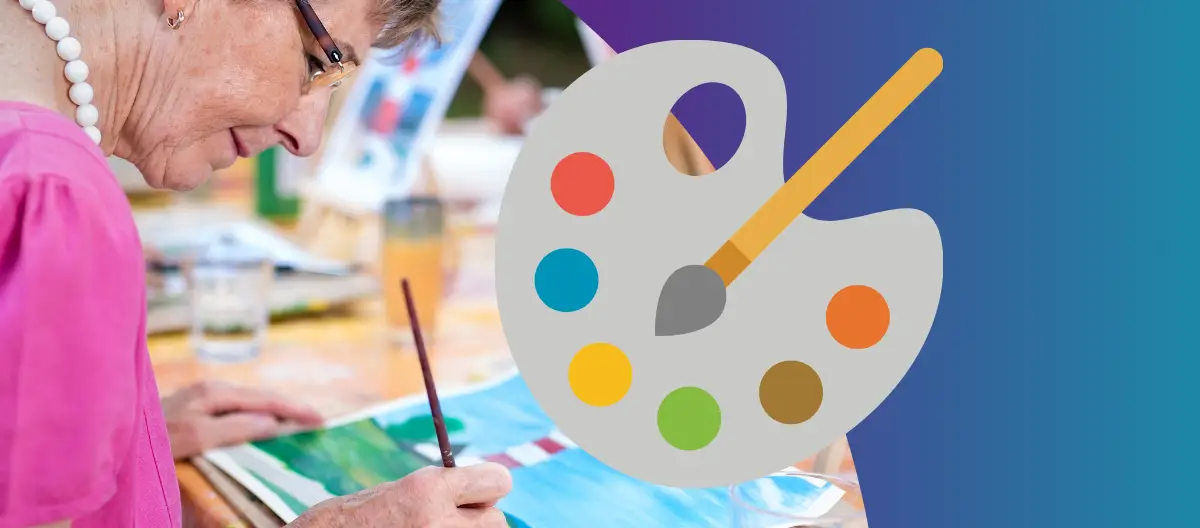As a care provider, you might have heard about the health benefits of art therapy. But what is art therapy, and how can it help your service users?
We all know that running an outstanding care service isn’t just about providing personal care. It’s also crucial to make sure that you consider your clients’ mental health. Art therapy can give them a regular activity to enjoy, as well as providing a crucial time to talk about or process their feelings.
In this article, we’ll explain what art therapy is, the physical and emotional benefits of art therapy, and how to manage some of the challenges you may encounter.

Table of Contents
What is art therapy?
Art therapy is a type of psychotherapy where people express themselves through painting, sculpting, drawing, or other art forms.
People taking part in art therapy are supported by a trained art therapist, who will help them express themselves and work through their thoughts and feelings.
Depending on the participants’ needs, art therapy might involve group or individual sessions.
Art therapy sessions might take place in care homes or day centres, hospitals, schools, or an art therapist’s own premises.
What happens during an art therapy session?
When someone first attends an art therapy session, the therapist may ask some questions to get to know them. This might take place during an art activity, if it helps them to open up.
The therapist will explain what art therapy is, and ask if the participants have any questions. This is the time for setting goals and outcomes, and checking in to make sure that everyone is comfortable.
Next, an art activity will be introduced. This might be drawing, painting, sculpture, or any other medium. Sometimes the art therapist will introduce a theme, such as loss, or sometimes the participants will have free rein.
One of the advantages of art therapy is that it can accommodate a variety of needs – for example, if a client struggles to work without instructions, the art therapist should be able to give regular suggestions. Some people may prefer to work in silence, whereas others will want to talk throughout the session.
The art therapist will make observations, and, at the end of the session, they will begin a discussion with the participants about their work, the process, and any other topics that come up.

Who does art therapy help?
Art therapy can help anyone, of any age – including children. It can be especially helpful for people who struggle to talk about their feelings or emotions.
Art therapy can help people experiencing a variety of mental health conditions, including depression and anxiety. If any of your customers experience psychosis, or have a diagnosis of schizophrenia or schizoaffective disorder, they may have already been referred for art therapy.
It can also help people who are grieving, struggling to come to terms with a change in their life, or people who have experienced trauma.
People taking part in art therapy don’t need to be accomplished artists – or even good at art. One of the advantages of art therapy is that participants may learn new skills, but it’s not an art class or lesson, and there’s no right or wrong outcome.
Art therapy benefits different people in different ways. Your customers’ differing needs may mean that an art therapist needs to run multiple sessions. Individual sessions might help people who don’t want to talk about their feelings in public, or who prefer to communicate one-to-one. Group sessions could work better for people who also want more social interaction.
Who can provide art therapy?
Art therapy is provided by trained art therapists. An art therapist should be registered with the Health and Care Professions Council (HCPC) and the British Association of Art Therapists (BAAT). You can use the BAAT website to find an art therapist to support your clients.
In the UK, the term art therapist is a protected title. Only people who are trained and registered can call themselves art therapists.

What are the health benefits of art therapy?
Art therapy benefits participants’ mental health, as you might expect – but it can also have positive physical benefits.
Psychological benefits of art therapy
As a care provider, many of your customers may struggle with low mood or anxiety, even if they don’t have a diagnosis of mental illness.
Art therapy has been shown to reduce anxiety and improve emotional regulation. It can be a relaxing experience, taking participants’ minds off their worries and allowing them to focus on something entirely different for a while.
If you run group art therapy sessions, your customers will benefit from the increased social interaction. Spending time with other service users can help reduce any feelings of loneliness or isolation, and may lead to lasting friendships. Even if your customers attend individual art therapy sessions, spending one-on-one time with the art therapist is also valuable social interaction.
If your customers have experienced trauma or loss, they may find that working through those experiences in art therapy helps them to heal and find acceptance. Some of your service users are probably reluctant to talk about past experiences, or don’t want to show their feelings, but art therapy can give them a new way to process what has happened to them.
Another of the advantages of art therapy is that it can provide cognitive stimulation. This is especially important for service users with memory problems or a diagnosis of dementia. Participants are empowered to make decisions about their art, and learn new skills as they work. This can help maintain or even improve cognitive function.
Physical benefits of art therapy
By helping people relieve stress and anxiety, there are real physical benefits of art therapy as well.
Lower levels of stress have been linked to:
- Lower blood pressure
- Lower reported pain levels
- Improved sleep
- Improved control of blood sugar
- Improved digestion
- Improved breathing
- Improved immune system
In addition, art therapy is often a physical activity in itself. It can help customers with their hand-eye co-ordination and fine motor skills.

What are the challenges of art therapy in social care?
Now that you know about the advantages of art therapy, you might be excited to use it to help your clients. Unfortunately, it can sometimes be hard to arrange art therapy sessions in care facilities or private settings. You might run into some of the following problems:
Lack of interest from customers
Your customers may seem uninterested or actively opposed to the idea of art therapy. This might be because they’re not familiar with the concept, they don’t understand the health benefits of art therapy, or because they don’t like the idea of therapy at all – especially in a group session.
Running a one-off taster session might be a good start to encourage service users to consider attending art therapy on a more long-term basis. Alternatively, some customers might prefer to attend individual art therapy sessions, rather than working as a group.
Communication or mobility issues making it hard for customers to take part
You may be concerned about how some customers would participate in art therapy sessions.
If they struggle to communicate, have limited English, are visually impaired, or have significant mobility difficulties, you should discuss these concerns with the art therapist ahead a session. Art therapy benefits many people with communication difficulties, and your art therapist may have ideas about how to accommodate your service users.

Lack of time to arrange and facilitate the service
As we all know, resources are often scarce in many care facilities – and that includes staff time. You may think that you don’t have time to locate an art therapist, or that you would struggle to allocate carers to support customers during a session.
Using care management software could help free up some time, either for you or your team.
Lack of space to hold art therapy sessions
Not every care home has a suitable activity room or communal area.
If you can’t accommodate sessions within your facility, you could see if any local art therapists hold sessions elsewhere that your customers could attend.
Difficulty finding a qualified art therapist
If you’re located in a major urban area, you’re probably able to find most services locally – but what if you’re based in a more remote or rural area?
If you’ve already looked on the BAAT website and can’t find a local art therapist, this might be a hard problem to overcome. However, there are some alternatives to art therapy that you could try.
Alternatives to art therapy
Do you want your service users to enjoy the psychological benefits of art therapy, but you can’t arrange sessions with an art therapist? There are a few alternatives you could try.
If you’d like to encourage creativity and harness the intellectual benefits of art therapy for your customers, consider running art workshops. If you have staff time available in your care roster, these could be run by a carer or activity co-ordinator. Alternatively, you may be able to find a local art teacher or volunteer who can manage these sessions.
If you think your customers would benefit from having a space to open up and discuss their feelings and memories, you could arrange themed discussion groups or reminiscence sessions.
If you can’t arrange for art therapy in your care facility, you could also see if there are any art therapy sessions being run locally. Organisations such as the BAAT or Mind may be able to help you find sessions.
Final words on art therapy in social care
There are few downsides and many advantages of art therapy. Unlike medication, it’s unlikely to cause physical side effects.
However, participants in art therapy may experience higher levels of stress or anxiety while they’re processing difficult emotions or trauma. As a care provider, you should be aware of this possibility, and plan accordingly.
It’s important to note that art therapy is often used in conjunction with medication and additional therapies. If you have concerns about the mental health of any of your service users, contact their GP or specialist, or encourage them to do so themselves.






